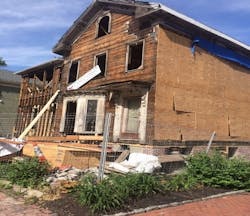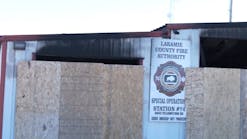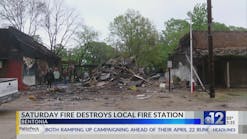There have already been 10 newsworthy events related to construction site fires in 2017. They occurred in Knoxville, TN, on Jan. 5; Maplewood, NJ, on Feb. 4; Raleigh, NC, on March 17; Overland Park, KS, on March 20; College Park, MD, on April 24; Emeryville, CA on May 12; Los Angeles on June 12; Boston on June 28; London, England on July 2 and today in Oakland, CA. Ironically, the construction site in Maplewood, NJ, had two previous fires in 2010 and 2015.
Historical construction site fires
As with any other fire, life safety and property conservation hold two key purposes of why the fire service exists and history has shown that firefighters have been seriously injured and killed at construction site fires.
On June 17, 1972, a fire at the Hotel Vendome in Boston killed nine firefighters and injured eight others when a collapse took place an hour after the fire was determined extinguished. The investigation found that, during an active remodeling, large portions of structural steel were removed in one wing of the structure to allow for new ventilation duct work.
The devastating effects of 9/11 led to the necessity to dismantle the Deutsche Bank in New York City. On Aug. 18, 2007, two FDNY firefighters were killed as efforts were hampered due to vital standpipes being removed too early in the demolition process.
Again in Boston, on March 26, 2014, unpermitted contractors welding an external handrail had red-hot slag find its way into an adjacent building causing the fire that killed two firefighters.
On Dec. 3, 2016 in Cambridge, MA, a small fire in a conventional three-family dwelling being completely gut-remodeled turned into a 10-alarm raging fire that effected 18 residential buildings and required an expansive amount of mutual-aid assistance. Miraculously, there were no civilian or firefighter lives lost or significantly injured during this event. These are just a few examples and there is no doubt that there have been numerous other significant fires involving construction.
In 2014, the National Fire Protection Association (NFPA) published a report where $187 million out of more than $654 million in fire losses, were lost in just 21 structure fires. Thirteen of these fires linked causes to heat and hot work too close to combustibles. Seven were related to buildings undergoing different stages of construction.
Prevention at the local level
With the high-speed construction industry, there is a likelihood that most fire departments are not even aware that there is a building undergoing construction within their jurisdiction until it is too late. Some fire departments may be aware of construction projects within their jurisdictions, yet they may not know that they can be have a voice in its fire safety. Other fire departments may know that there are codes and standards available and further take a position to be proactive with strong enforcement. This approach could lead to frustrations where fire service members may feel the construction industry may not be taking them seriously.
Buildings under construction become vulnerable to fire. Some reasons are because active fire protection systems—such as sprinklers and alarms, along with their passive fire protection in the form of gypsum wallboard—are either nonexistent, incomplete or impaired. Housekeeping factors contributing to the issue are flammable and combustible materials that somehow get ignited from a heat source. Hot-work processes, smoking products and heating appliances are typical sources of ignition.
A typical small-scale construction site may look like the one in Photo 3. The structure is aesthetically out of place and would appear to be a simple pile of combustibles waiting for an ignition source. A fire company could spot a site like this while doing some sort of neighborhood familiarization activity or maybe even stumble upon it before or after an unrelated fire or EMS call in the area. Coupled with the mental analyzing of seeing actual holes in the roof or missing floors and stairs begins to give the fire company an uneasy feeling as they imagine the building on fire. Scrambling thoughts of possible code violations starts the process of pulling in more technically savvy fire prevention and building officials in hopes something can be done to make this go away or at least not have a fire incident during that work shift. Occasionally, the outcome of the code enforcement leads to undesired setbacks for property owners when things like stop work orders are issued.
Today’s world now has the reality for construction sites to look like Photo 4. These take a much different track. Many come with full or partial occupancy while under construction. The enveloping of construction staging and protective barriers should bring a natural concern for occupant and fire service ingress and egress. The unknown status of which fire protection features are active or impaired or the location and quantity of flammable and combustible products should raise additional concern for the fire service.
Fire companies and code enforcers need to be vigilant when it comes to construction sites and visit them as often as possible. This is to keep a watchful eye on changing site developments. Fire department members visiting construction sites during non-fire/EMS emergencies should use behavior consistent to any other invited guest. Most construction personnel will be receptive to a visit at any time, however, sometimes rescheduling may be necessary. When construction personnel are wearing hard hats, safety glasses and reflective vests then so should their visitors.
Housekeeping on a construction site will always be the most challenging task for management in the industry. Common items to watch for are:
- Accessibility is maintained to the site from the perimeter including streets and hydrants for apparatus placement
- Ingress and egress doors, stairs, and corridors are in a usable condition
- Ignition sources and processes such as smoking, heating units and hot work, including flammable gases, are properly permitted, stored and used appropriately
- Good management of accumulation and location of combustible construction and waste materials
- Utility shutoffs and controls for electric, gas and fuel oil are readily accessible
- Permanently fixed or temporary alarms, standpipe and sprinkler systems and portable extinguishers are in place for immediate use
Another very important item, and probably the most overlooked, is the importance of identifying the individual on site who is the fire prevention program manager. This person is charged with being responsible for the fire safety planning and implementation. Very few building owners and construction contractors know of this role or what those duties include. This is one of the biggest gaps in the industry that is slowly making progress.
In sum
There is a lot of work ahead of us in the fire service when dealing with construction site fire safety, including interactions with the contractors and building owners. What seems to be working is enforcement through the implementation of education and training programs geared toward fire prevention. This approach is a much better choice than the last-minute enforcement style that confuses property owners and construction teams, which further causes delays in their projects.
Owners and construction contractors are not blind or silent to fire safety needs. They are simply, most likely, caught up in the fast pace of time constraints with deadlines to meet and charged with keeping overall costs to a minimum. The reality of fire safety is probably assumed that someone else is taking care of that or the rules and regulations of an entity like what OSHA prescribes are being followed to cover all the fire safety needs.
If we continue to reach out to contractors and owners with the purpose to engage them with our issues, we can guide them through the codes at hand in a fashion completely different from the conventional force feeding of regulations. This style is proving that the time to start talking fire safety awareness and planning is in the relaxed environment early in the process. This is where discussions with the property owners, construction design teams and installation contractors can be far more receptive for getting the point across explaining the fire service jurisdictional needs. Fire safety plans at a minimum will need to address each construction’s site specific needs. NFPA 241 www.nfpa.org/241 has fire safeguarding information that addresses certain individual’s responsibilities, planning and contributing construction processes. This standard can be used as a tool for assisting all stakeholders with guidance.
To keep this momentum moving forward, it will be imperative that there be collaborative leg work among the fire and building officials, the building owners, the design engineering consultants, and the general contractor associations. This relationship has the representation necessary to achieve maximum construction site fire safety results.






